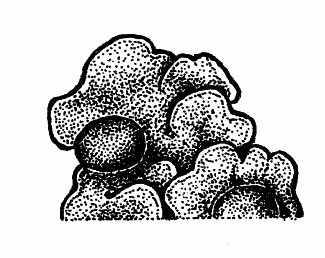Psora tuckermanii R. Anderson ex Timdal
Polished pennies
Psoraceae
Introduction to the Lichens
Polished pennies
Psoraceae
Introduction to the Lichens
Map
Distribution of Psora tuckermanii unavailable
Species Information
General:
Common Name: The Scale Lichens. Suggested by the tiny, rounded, often somewhat overlapping lobes of the species.
Small stratified squamulose lichens, corticate above, corticate or not below, nonsorediate, nonisidiate, squamules broadly attached to substrate or more often attached at one margin, closely appressed to loosely attached, short to more often subrotund, averaging to 2–5 (–8) mm wide, usually rather thick. Upper surface pinkish or more often brownish, somewhat shiny or not, often white-pruinose. Lower surface pale or darkening, lacking rhizines. Medulla white. Photobiont green.
Apothecia located over upper surface or along squamule margins, disc usually convex or hemispherical when mature, reddish brown to black; spores simple, ellipsoid, colourless, 8 per ascus.
Over exposed, base-rich soil or rock.
Notes: Psora is primarily a genus of semi-arid or arid areas, especially at temperate latitudes. Of the 17 species reported for North America, seven are found in B.C. This is a taxonomically difficult genus in which the species are not always clearly circumscribed.
Species description:
Over soil, moss or occasionally base-rich rock; lower surface pale, sometimes cottony; fruiting bodies (apothecia) not immersed, usually hemispherical at maturityAND
Apothecia reddish brown, brown or black, situated primarily over upper surface of lobes (check young apothecia); lobes appressed or ascending; upper surface never bright red AND
Lobes appressed or at most weakly raised, not distinctly ascending; upper surface brownish; apothecia simple, black to reddish brown AND
Apothecia reddish brown to at most medium brown; upper surface generally pale reddish brown AND
Apothecia strongly convex, usually hemispherical; gyrophoric acid absent; common
OR
Over soil, moss or occasionally base-rich rock; lower surface pale, sometimes cottony; fruiting bodies (apothecia) not immersed, usually hemispherical at maturityAND
Apothecia reddish brown, brown or black, situated primarily over upper surface of lobes (check young apothecia); lobes appressed or ascending; upper surface never bright red AND
Lobes appressed or at most weakly raised, not distinctly ascending; upper surface brownish; apothecia simple, black to reddish brown AND
Apothecia dark brown to black; upper surface generally dark brownish AND
Lobes not or only faintly white-pruinose along margins (but occasionally pruinose on upper surface, especially near margins); lower surface brownish AND
Apothecia strongly convex (often hemispherical) at maturity; lobes averaging to more than 1 mm wide; upper surface at most weakly pruinose, often distinctly fissured; medulla KC-, lacking gyrophoric acid; distribution various AND
Upper surface less shiny, creamy brown to medium brown (rarely dark)
Comments:
Psora tuckermanii occasionally bears blackish apothecia and may be difficult to distinguish from P. globifera.Such forms, however, are not known to occur in B.C.
Reactions:
All spot tests negative.
Contents:
No lichen substances reported.
Source: Lichens of British Columbia
Illustration

If more than one illustration is available for a species (e.g., separate illustrations were provided for two subspecies) then links to the separate images will be provided below. Note that individual subspecies or varietal illustrations are not always available.
Illustration By: Trevor Goward
Habitat and Range
Habitat: Frequent over base-rich soil and rock in open lowland sites in dry intermontane (BG, PP, IDF zones)World Distribution: western N Am, S to CA and NM.
Source: Lichens of British Columbia